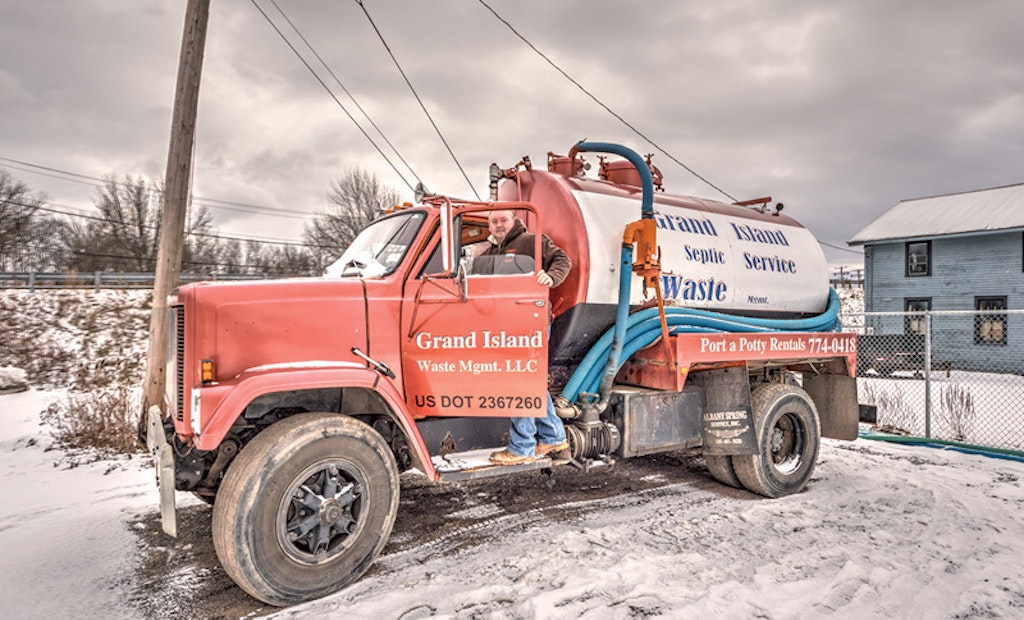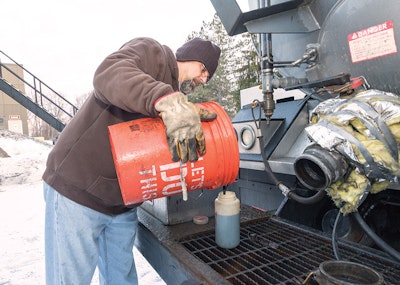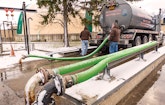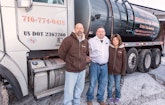
Interested in Onsite Systems?
Get Onsite Systems articles, news and videos right in your inbox! Sign up now.
Onsite Systems + Get AlertsAn island would seem too small a service territory for a pumper, but not for Jim Ehde. Grand Island, New York, has been his home for many years and is now the site and source of his new wastewater business. And a rich source it is.
Grand Island sits in the Niagara River just a couple miles upstream of the famous waterfalls. Part of it is served by onsite wastewater systems. Part of it is served by a small municipal wastewater plant. All of it is surrounded by urban America. A freeway crossing the island brings commuters from the nearby cities of Buffalo and Niagara Falls, and the combination of open land and easy access to water makes Grand Island a recreation hub as well as a place for year-round residents. This combination of people and place creates several business opportunities, and the spread of nearby cities has pushed the competition far enough away to leave Grand Island Waste Management with an almost wide-open territory Ehde is just beginning to explore.
WORKING THE HOME FRONT
Ehde, 57, was born and raised on the island, and knows the people and their needs. It was his own need as a homeowner that brought him into the wastewater business. “I needed my septic tank pumped, and there was nobody on Grand Island who provided that service, and I was not aware of that,” he says.
Other pumping companies serving the island are 20 to 30 miles away, out in the countryside, beyond the cities and suburbs. At the same time, he was looking for a change of career. He was working as a computer network analyst at the General Motors factory in Buffalo that produced engines for Chevrolet Silverado pickups and Corvettes. In 2009 he started looking at options.
He didn’t want to go back to his previous career in restaurants. On the island it was a very competitive business even for someone who was once a corporate trainer for the TGI Fridays chain. But previous careers provided him with useful skills. From the restaurant industry he learned how to work with employees. The information technology background helped him do calculations and read a profit-and-loss sheet.
For a year he researched the pumping business. He found out how many septic tanks were on the island and how often they needed pumping. He compiled numbers and connected with SCORE, a nonprofit organization with volunteer mentors who are experienced small-business people.
“I started the wastewater business figuring this is my retirement. I like to stay busy, and I don’t see myself ever retiring,” he says. At first he did both jobs. This year he left GM to run Grand Island Waste Management full time.
This is the result of the preparation, mentoring and hard work: In the first three years his business grew 50 percent each year. In 2016, the fourth year, it grew 120 percent.
ISLAND OF OPPORTUNITY
Grand Island has a population of about 20,000. In the late 1800s and early 1900s, when financial barons such as Andrew Carnegie and J.P. Morgan were prominent, the island was a summer resort. Ferries took people to the island then.
Today, they can zip across a bridge on Interstate 190 that connects Buffalo to Niagara Falls. The freeway divides the island in more ways than one. About half of the population lives east of the freeway, and mostly their wastewater flows to the Grand Island municipal plant on the northern end of the island. The other half of the population lives to the west of the freeway, and by and large their wastewater is disposed of with onsite systems. Some of the tanks are so old that they don’t even have drainfields, but discharge directly into streams. And this is an environmentally sensitive area.
“You’re on an island, and most of the septic tanks are within a half-mile of the river. We do have some of the poorer water quality rates in the area,” Ehde says.
He wants to help solve this problem by pushing for more education and a rule mandating pumping every three to five years, but the data does not exist to support his position to the degree he would like.
“This is a pretty affluent community, so a lot of people do fertilize their lawns, but from what I’ve seen, I’m guessing a lot of the contamination is from septic tanks. We come across a few tanks that haven’t been pumped in 40 or 50 years,” he says.
HELPING BY TEACHING
After a slow period, development on the island is booming.
“What’s happening now is people are moving here from cities, and they have never had septic systems. That’s where I’m getting most of my new customers from, and to help them I taught a class on wastewater,” Ehde says. Although many people maintain their onsite systems, others do not and do not understand the eventual effect on their wallets.
“It started because everywhere I went I heard people saying, ‘Oh, you don’t have to pump those things.’ I had a guy who had a new tank and thought it didn’t have to be pumped because it has a sand filter,” Ehde explains. “I’m telling them it’s a small fee, just as they pay somebody to cut the grass every year and plow the driveway.”
About 60 people showed up for the workshop on how septic systems work. It was sponsored by the Erie County Health Department and the township’s Conservation Advisory Board, a group of volunteers who work on environmental issues. Ehde has already told the sponsors that he would be willing to teach another class even if it’s off the island.
“I printed out a chart showing how the number of people in a house governs how often they need to be pumped,” he says. He showed pictures of the problems that can result when tanks aren’t pumped. “And I tell them it’s better to pay me $200 to $260 than to pay someone else $15,000 to put in a new system.”
KEEP IT LOCAL
To promote his business, Ehde advocates the idea of buying local. He stresses to customers that money spent on the island tends to stay on the island. It helps support other businesses and pays taxes. The community’s response to the message has been overwhelming, and Ehde is grateful for it.
“We’re very active on Facebook, and because we’re close by, people see that we can respond to their calls within a day. Most companies from farther away have set days to come to the island, and they are reluctant to respond outside of those times because it means sending a truck for only one job,” he says.
The island is so compact that Ehde puts only about 6,000 miles on his truck each year. And if he restricts himself to pumping on the island, he can dump all the septage at the island’s wastewater plant. That saves the 24-mile round trip to Buffalo, an hour-long haul through traffic and on toll roads.
“Most of our growth has been organic: thorough lifelong relationships and word-of-mouth, and some of our work on Facebook. I haven’t had time to pursue more business, not even for my portable restrooms,” he says.
He has restrooms, all standard PolyJohn Enterprises units, and four PolyJohn hand-wash stations. These are placed in local parks, and they’re rented by people whose houses are a long way from their boat docks and who want to spend as much time on the water as possible. There are opportunities for this part of the business off the island, and if those plans work out, Ehde will be expanding by about 200 more units.
Another service he provides on and off the island is pumping restaurant grease traps. Because of his history in the restaurant industry, he knows many restaurant owners, and those relationships make getting contracts easier.
He is also thinking about adding a trash container service for businesses, restaurants and gas stations. Again his push for buying local helps, and so will relationships. He grew up with many of the small-business owners he would now like to serve.
“My whole idea in putting the words ‘waste management’ in the company name was to allow us to expand, to offer not only pumping and portable restrooms but also (containers). We have a niche market here, a closed community, and the services I mentioned are those people have already asked me for. I just can’t grow fast enough to meet the need.” he says.
ADDED VALUE
Boats provide another source of revenue. Sometimes it’s owners who haven’t had a chance to pump their holding tanks. Also on the schedule is pumping holding tanks for dinner cruise boats that moor along the river. These boats are typically 40 to 70 feet long, and they need weekly pumping. That relationship provides a nice bonus for his employees. Once a year he takes his workers and their families out for a dinner cruise.
In addition to pumping tanks, Ehde has the contract to haul sludge from the local municipal wastewater treatment plant.
Ehde is not worried that municipal sewer will spread to the other half the island and push out septic systems.
“The cost of installing sewers there would be too great. All the homes are spread out. Lots are 3 or 5 acres, and homes are 100 to 300 feet away from the road,” he says.
Ehde’s fleet is simple but versatile. He has:
- • A 2012 Freightliner carrying a 5,000-gallon Pik Rite steel tank and a Jurop pump. He bought this truck used.
- • A 1985 GMC with a 2,500-gallon steel tank from Industrial & Municipal Engineering with a Pearson pump. This truck was also bought used and was a municipal vehicle with only 25,000 miles on it.
- • A 2014 Chevy Silverado and Lane Trailers trailer used to deliver portable restrooms.
The GMC truck is the vehicle of choice for servicing portable restrooms and for homes with long driveways that won’t support the weight of the big truck.
He doesn’t own a jetter or camera or some other common tools. There are several plumbers on the island, and Ehde works with them. When he finds a line that requires inspection, he calls them, and when they have a customer whose tank needs pumping, they call him. When he installs lids and risers, he uses Tuf-Tite products.
ON THE HORIZON
Eventually Ehde will expand, but he already has a limit in his head. That limit is the island. Grand Island is large enough to decently support his family: himself; his wife, Christine; and stepson, Matt. Ehde is the only full-time worker, but crew help comes from Steve and Tyler Ehde, and Don Phillips.
“I’m not looking to become some huge company,’’ he says. “I’m looking to take care of my family and employ a few people.”











